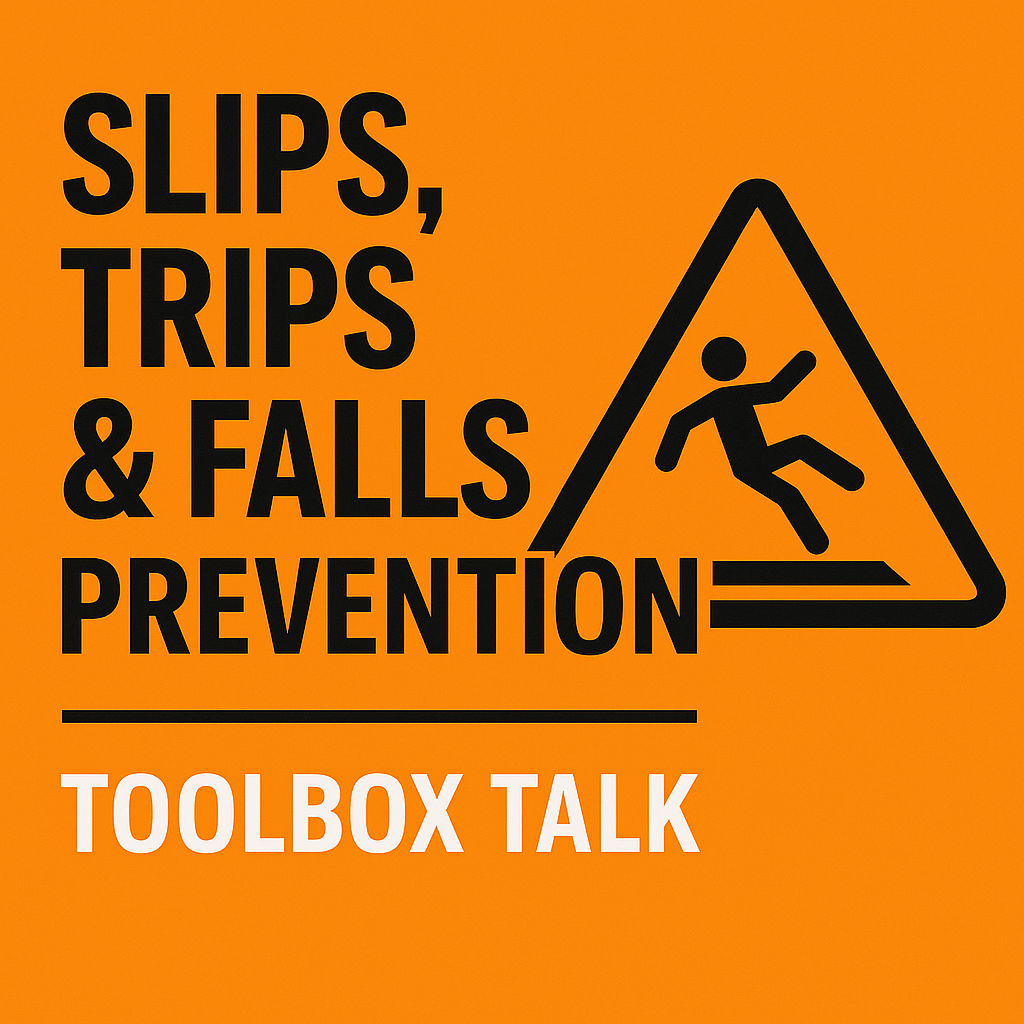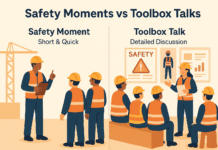
Slips Trips and Falls Prevention TBT
Good Morning Team
Good morning, everyone.
Today, we’re going to talk about one of the most common causes of workplace accidents — Slips, Trips, and Falls.
These accidents may sound simple or minor, but in reality, they are a leading cause of injuries in workplaces across the world. They can lead to broken bones, head injuries, back strains, and even fatalities in severe cases. The good news is — almost all of them are preventable with awareness and simple safety practices.
1. Why This Topic Is Important
Slips, trips, and falls account for millions of lost workdays every year.
They are common in all industries — from construction sites to offices, from warehouses to manufacturing plants.
Some important facts:
- Slips occur when there’s too little traction between your footwear and the walking surface.
- Trips happen when your foot strikes an object, causing you to lose balance.
- Falls occur when you come down suddenly from a higher level to a lower one — or even at the same level.
2. Common Causes of Slips
- Wet or oily surfaces (spills, leaks, rainwater at entrances).
- Loose rugs or mats.
- Smooth floors without slip-resistant coating.
- Weather hazards like ice, frost, or mud.
- Improper footwear with worn-out soles.
3. Common Causes of Trips
- Clutter in walkways.
- Uncovered cables and hoses.
- Uneven flooring or broken tiles.
- Poor lighting in corridors or staircases.
- Open drawers left unattended.
4. Common Causes of Falls
- Using ladders improperly.
- Working at heights without fall protection.
- Jumping from vehicles or platforms.
- Damaged steps or stairs.
- No guardrails or barriers where needed.
5. Preventing Slips
- Clean spills immediately — mark the area with a wet floor sign until dry.
- Wear slip-resistant footwear.
- Use floor mats at entrances and wet-prone areas.
- Maintain good drainage in work areas.
- Apply non-slip floor coatings where possible.
6. Preventing Trips
- Keep walkways clear of boxes, tools, or debris.
- Route cables and hoses overhead or use floor cable covers.
- Repair uneven floors and loose tiles.
- Ensure adequate lighting in all areas.
- Close drawers and cabinets immediately after use.
7. Preventing Falls
- Always use ladders correctly — no climbing on top rungs.
- Inspect ladders and scaffolds before use.
- Wear fall protection equipment when working at height.
- Install handrails and guardrails.
- Avoid jumping from elevated surfaces.
8. Housekeeping’s Role
Many slips, trips, and falls are the result of poor housekeeping.
Make it a habit to:
- Put tools and materials back in their place.
- Sweep or vacuum debris.
- Remove obstacles from walkways.
- Report damaged flooring or lighting immediately.
9. Weather Considerations
- On rainy days, ensure floor mats are in place and replaced when soaked.
- In cold weather, use salt or sand on icy paths.
- Provide covered walkways where possible.
10. Reporting Hazards
If you see something unsafe, report it immediately to your supervisor.
Do not assume someone else will fix it — be proactive.
📌 Real-World Example
In a warehouse, a worker slipped on a small patch of oil that had leaked from a forklift. The spill was not large, but because it was not cleaned promptly, the worker fractured their wrist while falling. This incident led to two weeks off work and thousands in medical costs.
Had the oil spill been cleaned immediately, this injury could have been avoided. Small hazards can have big consequences.
💡 Safety Tip
Your own awareness is the best defense. Stay alert, watch your step, and remember — if it looks unsafe, it probably is.
11. Key Takeaways
- Most slips, trips, and falls are preventable.
- Good housekeeping is the foundation of prevention.
- Wear the right footwear for the job.
- Keep walkways clear and well-lit.
- Report and fix hazards immediately.
12. Quick Self-Check Before You Walk
Before moving through any area:
- Look for spills, debris, or cords.
- Make sure lighting is adequate.
- Check your footwear is secure.
- Carry loads that allow you to see where you’re going.
Questions for the Team
- What’s the most common slip or trip hazard in your work area?
- How quickly are hazards typically cleaned or reported here?
- What extra measures can we take to prevent falls in our workplace?
Strong Closing
Alright team, remember: Slips, trips, and falls are not accidents — they are the result of hazards we can control.
Every step you take on site is your responsibility. Watch out for each other, report hazards, and take preventive action immediately.
If we all stay alert and act quickly, we can ensure everyone goes home safe and injury-free at the end of the day.
Let’s make today a hazard-free day — stay sharp, stay safe!
Hand and Power Tool Safety TBT
























